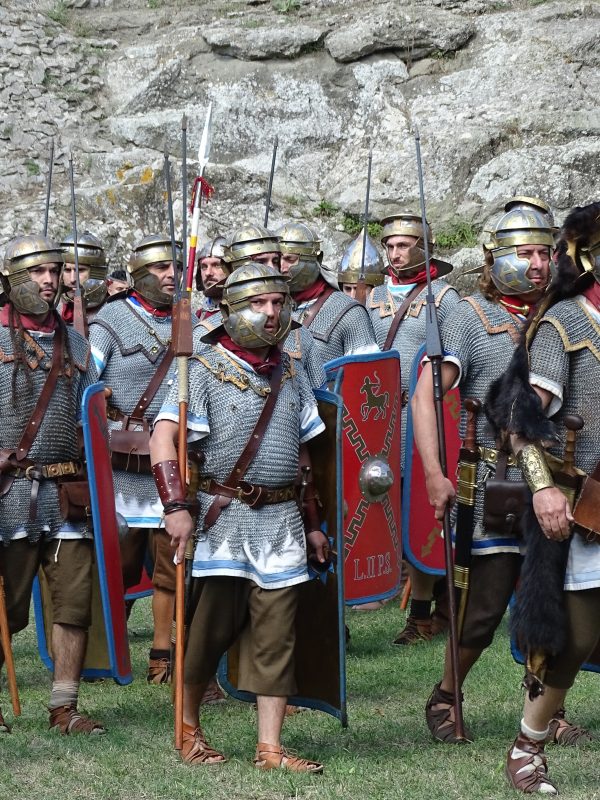The first signs of human life on the territory of the Alban Hills date back to the Lower Palaeolithic Period (300.000 – 200.000 years ago). Flint tools (stone chopper tools as well as the “amigdale”, a double sided hand axe) were discovered in the area.
However, the first populations to permanently settle in the area of the Castelli Romani were the Latins, Indo-European populations that had settled in the Ancient Latium (The Latium Vetus of Pliny the Elder which extended south of the Tiber up to Mount Circeo) since the year 2000 BC.
Four centuries before the foundation of Rome, the Latins had already established their towns here – Alba Longa, Tusculum, Ariccia, Lanuvio and Velletri to name only the most important – which were firmly allied in a confederation, the Lega Latina (Latin League).
The heart of the religious and political life of the confederation was found on what is named today “Monte Cavo”, the ancient Mons Albanus where the sacred Temple of Jupiter (Juppiter Latiaris) had been built and where the Feriae Latinae were celebrated every year. During the celebrations, the representatives of the League met again, and reinforced reciprocal bonds of membership and alliance.
For centuries, the Latins were against Rome, and many battles were fought by the Romans to dominate them. In spite of the destruction of their capital city Albalonga in the 7th century BC (by command of Tullus Hostilius and attributed by tradition to the victory of the Horatii and Curiatii), the Latin League was eventually defeated – and therefore dissolved – only three centuries later in the year 338 BC. From this time onwards, the Castelli Romani were under the Roman rule. In the year 193 AD, Septimius Severus ordered the construction of the Castra Albana (the Roman camps from where the town of Albano originated) for the Second Parthian Legion, who had the role of the emperor’s bodyguards.
Important people from ancient Rome preferred the Alban Hills and chose this area to build their residence. For example, to name a few, the Emperor Domitian had a vast estate, which entirely surrounded the Lake Albano, while Caligola kept his two luxurious “floating villas” anchored in Lake Nemi.
The barbaric invasions that horrified the Italic peninsula, and that brought about the fall of the Western Roman Empire in 476 AD, also brought about the phenomenon of the so-called “incastellamento” in the Alban Hills. Here, the populations took refuge in the hills to shelter from the barbaric invasions. Several noble families built their fortresses here and, throughout the centuries, small villages developed and later became the Castelli Romani.
As of the 10th century, the rise of the powerful Counts of Tusculum, already established in the ancient town of Tusculum, began. It was a member of this family that donated the estate to Saint Nilus in 1004 on which the monks founded the Abbey of Grottaferrata.
Even after the fall of the Empire, the town that once was caput mundi did not cease to dominate the Alban Hills. During the following centuries in fact, they were taken over by the Church of Rome, which gradually became the owner of all the properties in the area.
Throughout the Middle Ages, the territory of the Castelli Romani became a scene of perpetual battles of power, led by the most important Roman feudatory families, many of which belonged to the clergy.
In 1167, the imperial troops of Frederick Barbarossa defeated the military force of Pope Alessandro III in the battle of Prata Porci, below Monteporzio Catone; afterwards, with the withdrawal of the imperial army, Rome decided to eliminate the towns of Albanum and Tusculum, which in the above mentioned events had lined up with the Emperor in disdain of the Church of Rome.
In 1379, a year after the beginning of the Western Schism, the army of Breton and Gascon mercenaries, under paid command of antipope Clement VII, challenged the troops of Pope Urban VI in the famous battle of Marino, where the Pontifical troops claimed a crucial victory.
In 1433, the Roman Barons rebelled against Pope Eugenio IV causing a three-year war during which many towns of the Castelli Romani were involved. It concluded in 1436 when the Pope’s army commanded by Cardinal Vitelleschi destroyed Albano Laziale.
In 1501 Marino, fiefdom of the powerful Colonna family was also razed to the ground in the war against Pope Alessandro VI.
Eventually, in 1527 when the Landsknechts ransacked Rome, the Castelli Romani were also robbed and destroyed, in particular Marino and Velletri. In this devastating situation, Frascati was saved from slaughter by a miraculous blessing that the devoted population attributes to the Virgin Mary.
From halfway through the 16th century to the end of the 18th century the Castelli Romani enjoyed a flourishing period of peace and stability. During these two centuries, the aristocratic Roman families competed in building, enhancing and rebuilding their luxurious country residences and the elegant parks and gardens, as well as improving the territory of the Castelli Romani area with important and valuable infrastructures and urban features.The most important examples, first of all, are the well known Villas of Tusculum situated among Frascati, Monteporzio Catone and Grottaferrata as well as Ariccia (the important Bernini complex in Piazza Repubblica with the Palazzo Chigi and the Chiesa dell’Assunta), the Papal Palace at Castel Gandolfo, the Sforza-Cesarini Palace at Genzano, the Colonna Palace at Marino and the Ferrajoil Palace at Albano, etc.
Peace ended in the Castelli Romani in the second half of the 18th century, when the War of the Austrian Succession broke out. It particularly involved Velletri where the Hispanic-Neapolitan troops of King Charles of Borbone challenged the Austrians in 1744 and won a historical victory that allowed the Kingdom of the two Sicily to survive.
About 50 years later, the Italian Campaigns of the French Revolutionary War led by Napoleon drove the French occupation as far as Rome, turning the towns of the Castelli Romani upside down and taking away territory and power from the Holy See. After the long period of the Restoration, in 1870 the Pontifical State became part of the Kingdom of Italy and likewise the territory of the Castelli Romani.
Important development and improvement of road and railway infrastructures had already started in 1856 under the rule of Pope Pio IX with the inauguration of the two railway lines Rome-Frascati and Rome-Velletri. Later lines followed between Rome-Grottaferrata, Frascati-Grottaferrata-Genzano, Grottaferrata-Rocca di Papa.
This helped to make the Castelli Romani become a favourite spot for the well-known Roman out-of-town trips as well as their summer holidays. Then, during the Second World War bombings almost all the towns of the Castelli Romani were bombed and destroyed.
Today, the Castelli Romani have once again become one of the most appreciated tourist spots in Lazio, both for the well-known typical wine & food and for the pleasant landscapes which have been well maintained thanks to the Regional Natural Park of the Castelli Romani.







 Visit Castelli Romani
Visit Castelli Romani 

